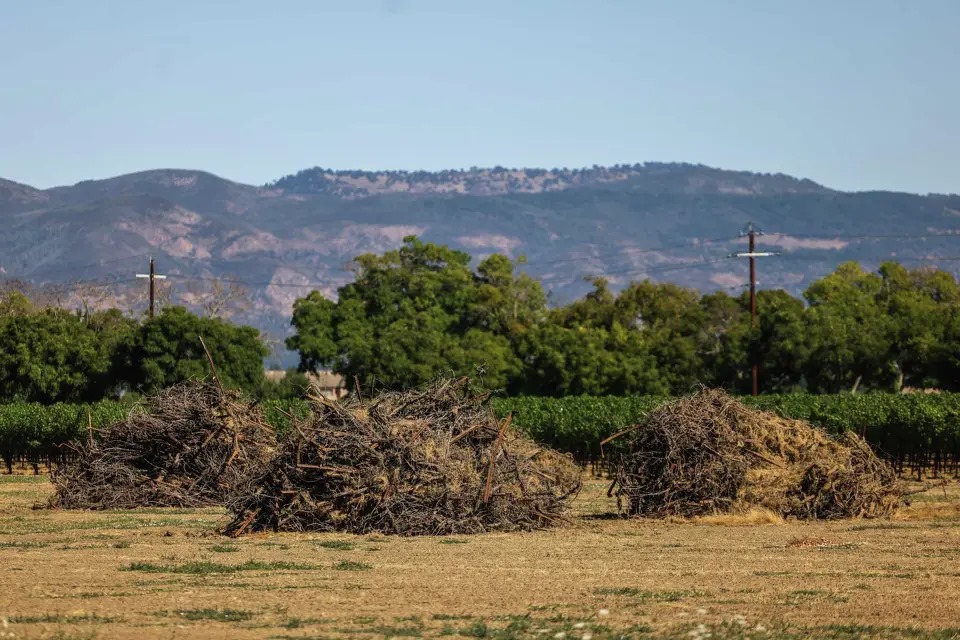
California’s Wine Harvest Faces Its Harshest Season Yet
A drive along Napa Valley’s Highway 29 this fall reveals a troubling new reality. Where lush vineyards once stretched across the hills, barren fields now dominate the landscape. Heaps of uprooted vines lie abandoned, a stark symbol of the crisis gripping California’s wine industry.
Despite near-perfect weather conditions, the state’s growers are facing one of their most difficult harvests in decades. Alcohol consumption in the United States has dropped to a 90-year low, leaving the market oversupplied with both grapes and wine. Tens of thousands of acres of vineyards have been destroyed or left untended, and experts estimate that more than 100,000 tons of grapes will rot on the vine for the second year in a row.
“We’re living in two worlds right now,” said Stuart Spencer, executive director of the Lodi Winegrape Commission. “The fruit looks beautiful, some of the best Zinfandel in years. But the reality of the market is dragging everything down.”
Last year, California recorded its smallest harvest in two decades, down 23% from 2023. Many growers slashed their prices by more than half in a desperate bid to cover basic costs. Yet even then, up to 400,000 tons of grapes were abandoned and nearly 40,000 acres of vineyards were ripped out.
This year offers little relief. Spencer estimates that Lodi alone has lost nearly a fifth of its vineyard acreage in recent years. Jeff Bitter, president of Allied Grape Growers, predicts another 35,000 to 40,000 acres will be removed statewide in 2025. More troubling is a newer trend: large swaths of vineyards being left to wither, as growers walk away entirely.
Jason Smith of Monterey County is one such grower. His family’s company, Valley Farm Management, once farmed more than 3,000 acres and employed 50 people. But as grape contracts vanished and banks refused loans without guaranteed sales, Smith made the painful choice to shut down after more than 50 years in business. “It’s our family’s legacy,” he said. “But the bottom line is the bottom line. We couldn’t keep going.”
Even in world-famous wine regions, the downturn is evident. Sonoma County Winegrowers project that about 10% of their vineyards will be pulled this year, with thousands of acres unlikely to be replanted. Nearly a third of the county’s grapes remain uncontracted, forcing growers to sell at a discount, turn them into low-value bulk wine, or leave them unharvested. Prices are projected to fall by another 7%.
READ MORE: Protecting the Roots of Australian Wine: Managing Grapevine Trunk Diseases for Vineyard Longevity
In Napa Valley, vineyard removals are also underway, with some growers using the downturn to clear diseased vines affected by red blotch. Still, sales remain stagnant. Listings for bulk wine and grapes have reached record highs, reflecting the sluggish market.
International trade has added to the woes. While tariffs on European wines were expected to help, imports remain cheaper, and bulk shipments to the U.S. are up 17% this year. Canada’s decision to lift its retaliatory tariff on American wines offers a sliver of hope, but it will take time for the effects to reach growers.
Wildfires have added fresh uncertainty. This summer’s Pickett Fire in Napa damaged more than 1,500 acres of vineyards, while others reported smoke exposure that could spoil grapes. Some wineries may buy replacement fruit, but these isolated needs won’t solve the statewide oversupply.
Industry leaders say the harsh truth is unavoidable: the only path forward is painful adjustment. “The answer is to produce less until we’re in balance,” Bitter said.
For now, California’s wine country — once a picture of prosperity — is grappling with a sobering reality: fewer vines, fewer buyers, and fewer reasons to raise a glass.



